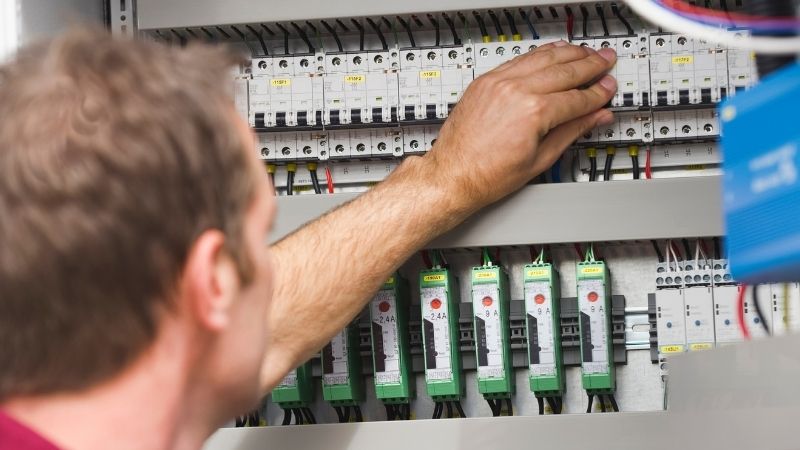Ghid esențial pentru defecțiunile PLC și tehnicile de depanare
În acest ghid, vom acoperi cauzele comune ale PLC defecțiuni, identificați semnele de avertizare și descrieți tehnicile de depanare pentru a vă ajuta să rezolvați problemele cu promptitudine și să minimizați timpul de nefuncționare.
Cuprins
Cauze comune ale defecțiunilor PLC
PLC-urile pot eșua din numeroase motive, de la factori de mediu până la erori ale operatorului. Înțelegerea acestor cauze este cheia pentru prevenirea defecțiunilor.
- Defecțiuni electrice: Surplusurile de tensiune, fluctuațiile de tensiune sau defecțiunile electrice pot deteriora componentele PLC-ului, ducând la defecțiuni. Întreținerea preventivă, inclusiv protecția la supratensiune și monitorizarea consecventă a sursei de alimentare, este esențială.
- Stresul de mediu: Expunerea la temperaturi ridicate, praf, umiditate și substanțe chimice corozive poate degrada performanța PLC-ului în timp. Curățarea regulată și protecția adecvată pot atenua aceste riscuri.
- Probleme de software: Defecțiunile software, cum ar fi erorile de programare sau incompatibilitățile, pot opri funcționarea PLC-ului. Menținerea software-ului actualizat și respectarea celor mai bune practici de programare poate preveni aceste erori.
- Deteriorarea componentelor: Ca și în cazul oricărui sistem mecanic, părțile unui PLC, cum ar fi ventilatoarele și conectorii, se pot uza în timpul utilizării. Inspecțiile periodice și înlocuirile la timp ajută la prevenirea defecțiunilor.
- Interferențe electromagnetice (EMI): Interferența de la echipamentele din apropiere poate perturba funcționalitatea PLC-ului. Implementarea de ecranare și împământare adecvată minimizează aceste probleme.
- Eroare umană: Erorile accidentale de introducere a datelor sau manipularea necorespunzătoare pot cauza defecțiuni. Antrenamentul adecvat și accesul controlat reduc probabilitatea acestor greșeli.
Indicatori cheie ai defecțiunii PLC
Detectarea semnelor timpurii ale problemelor PLC vă permite să le rezolvați înainte ca acestea să escaladeze.
- Intrări și ieșiri neregulate: Semnalele instabile de intrare și ieșire sunt un semn al potențialelor probleme în sistemul PLC.
- Instabilitatea puterii: O sursă de alimentare defectuoasă duce adesea la opriri ale sistemului sau defecțiuni intermitente.
- Zgomot electric: Interferența electrică de la surse externe poate perturba citirile și poate duce la comportamente neașteptate în PLC.
- Eșecuri de comunicare: Când un PLC pierde conexiunea la rețea sau prezintă erori frecvente de comunicare, poate indica o defecțiune internă.
- Supraîncălzire: Căldura excesivă în sistem poate indica probleme cu componentele interne, care pot deteriora părțile sensibile.
- Coruperea memoriei: Memoria coruptă dintr-un PLC poate duce la blocări ale sistemului și performanțe nesigure.
Pași de bază pentru depanarea PLC
O abordare sistematică poate rezolva multe probleme PLC în mod eficient.
- Verificați sursa de alimentare: Asigurați-vă că sursa de alimentare a PLC-ului este stabilă și funcționează corect. Testarea nivelurilor de tensiune și inspectarea conexiunilor de alimentare este un bun punct de plecare.
- Verificați integritatea terenului: Împământarea necorespunzătoare poate duce la zgomot electric. Asigurarea unei împământări adecvate va elimina interferențele, îmbunătățind performanța PLC-ului.
- Inspectați dispozitivele de intrare și ieșire: Defect senzori, actuatoarele sau conexiunile greșite pot cauza erori de sistem. Verificarea conexiunilor de intrare/ieșire ajută la izolarea componentelor defecte.
- Examinați indicatorii de stare: PLC-urile au adesea LED-uri sau indicatoare de diagnosticare. Revizuirea acestor indicatori și consultarea manualului PLC poate dezvălui coduri de eroare sau avertismente specifice.
Tehnici avansate de depanare
Metodele avansate sunt utile pentru probleme complexe sau defecțiuni recurente ale PLC-ului.
- Monitorizați comportamentul sistemului: Folosirea jurnalelor de tendințe și evenimente ajută la identificarea modelelor de performanță PLC. Urmărirea schimbărilor de temperatură, a fluctuațiilor de tensiune și a istoricului alarmelor poate dezvălui probleme de bază.
- Efectuați audituri de sistem: Auditarea regulată a cablajului PLC, a conexiunilor componentelor și a configurațiilor de programare ajută la identificarea potențialelor defecțiuni înainte ca acestea să afecteze operațiunile.
- Reglarea PID: Reglarea controlerelor PID (Proportional-Integral-Derivative) asigură un control precis asupra variabilelor sistemului. Reglarea corectă este crucială pentru stabilitatea în buclele de control complexe.
- Depanarea programului: Depanarea avansată poate implica parcurgerea codului PLC-ului pentru a identifica erorile software sau problemele logice. Multe mărci de PLC oferă instrumente de depanare în software-ul lor.
Întreținere preventivă pentru sisteme PLC
Întreținerea de rutină este vitală pentru extinderea duratei de viață și a performanței sistemelor PLC.
- Controlul mediului: Păstrarea PLC-ului într-un mediu stabil și curat previne deteriorarea cauzată de praf, umiditate și fluctuații de temperatură.
- Înlocuirea componentelor: Înlocuirea regulată a componentelor învechite, cum ar fi ventilatoarele și conectorii, reduce riscul defecțiunilor legate de uzură.
- Actualizări de software: Actualizările software consecvente îmbunătățesc funcționalitatea și securitatea, asigurând compatibilitatea cu alte componente industriale.
Utilizarea resurselor și asistenței
Utilizați resursele disponibile pentru a vă ajuta cu depanarea și reparațiile.
- Documentația furnizorului: Manualele și specificațiile tehnice sunt referințe valoroase atunci când diagnosticați și depanați problemele PLC.
- Forumuri și tutoriale online: Resursele online, inclusiv forumuri și tutoriale video, oferă sfaturi practice și sprijin comunitar din partea altor profesioniști.
- Experti in consultanta: Pentru probleme complexe, contactarea unui tehnician PLC cu experiență sau a unei echipe de asistență poate accelera depanarea și se poate asigura că reparațiile sunt eficiente.
Alimentați-vă proiectele cu PLC Omron, Mitsubishi, Schneider nou-nouț, original – în stoc, gata acum!
Concluzie
Menținerea unui sistem PLC este esențială pentru operațiuni industriale neîntrerupte. Înțelegând defecțiunile comune, identificând semnele de avertizare timpurie și urmând pașii sistematici de depanare, puteți minimiza timpul de nefuncționare și puteți menține fiabilitatea sistemului.
Încorporați întreținerea preventivă și rămâneți informat cu privire la cele mai bune practici de depanare pentru a vă menține procesele de automatizare să funcționeze fără probleme.
Căutați PLC-uri noi, originale pentru proiectele dvs.? La Kwoco, stocăm cele mai noi PLC-uri de la mărci de top precum Omron, Mitsubishi, și Schneider. Cumpărați cu încredere - livrare rapidă, calitate garantată! Cumpărați acum
Contactaţi-ne
Doar completați numele dvs., adresa de e-mail și o scurtă descriere a solicitării dvs. în acest formular. Vă vom contacta în termen de 24 de ore.
Categoria de produs
Produse de vânzare fierbinte
De asemenea, puteți găsi aceste subiecte interesante

Unități de frecvență variabilă (VFD): Ghid complet pentru controlul motorului
Un ghid cuprinzător pentru variatoarele de frecvență (VFD) – tehnologia care revoluționează controlul motoarelor în aplicațiile industriale. Indiferent dacă sunteți inginer, tehnician sau manager de instalație, acest articol vă va ajuta să înțelegeți cum funcționează VFD-urile și de ce sunt esențiale pentru aplicațiile moderne ale motoarelor.

Ce este PLC și de ce contează pentru afacerea dvs.?
Ce este PLC și de ce contează pentru afacerea dvs.? Te simți copleșit de schimbările constante ale automatizării industriale

Depanarea panourilor tactile industriale care nu răspund: un ghid cuprinzător
Panoul dvs. de ecran tactil industrial funcționează? Un ecran tactil care nu răspunde poate opri producția, poate crea frustrare și poate costa timp și bani prețios pentru afacerea dvs. Acest articol oferă un ghid cuprinzător pentru depanarea problemelor comune ale ecranului tactil industrial. Vom explora motivele din spatele unei atingeri care nu răspunde, pașii pe care îi puteți lua pentru a rezolva problema și când este timpul să apelați la profesioniști. Aflați cum să vă asigurați că HMI-urile dvs. industriale rămân fiabile și contribuie la operațiunile de producție fără probleme.






